ARISTON RDPG 96407 D AUS User Manual

Instructions for use
WASHER-DRYER |
|
|
|
|
|
|
|
|
! This symbol reminds you to read this instruc- |
|
|
GB |
||
tion manual. |
|
|
|
||
GB CN
English,1 Cinese,13
RDPG 96407
Contents
Installation, 2-3
Unpacking and levelling
Connecting the electricity and water supplies
The first wash cycle
Technical data
Care and maintenance, 4
Cutting off the water and electricity supplies
Cleaning the washer-dryer
Cleaning the detergent dispenser drawer
Caring for the door and drum of your appliance
Cleaning the pump
Checking the water inlet hose
Precautions and tips, 5
General safety
Disposal
Opening the porthole door manually
Description of the washer-dryer, 6-7
Control panel Display
How to run a wash cycle or a drying cycle, 8
Wash cycles, 9
Table of programmes and wash cycles
Detergents and laundry, 10
Detergent dispenser drawer
Preparing the laundry
Special wash cycles
Load balancing system
Troubleshooting, 11
Service, 12
1
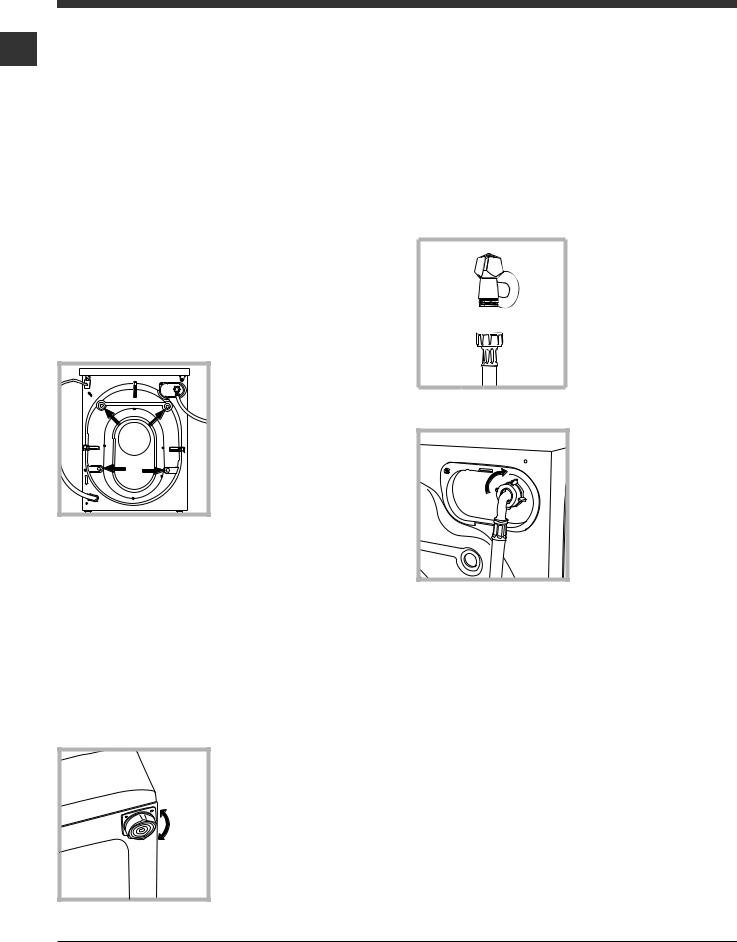
Installation
! This instruction manual should be kept in a safe GB place for future reference. If the washer-dryer is
sold, transferred or moved, make sure that the instruction manual remains with the machine so that the new owner is able to familiarise himself/ herself with its operation and features.
! Read these instructions carefully: they contain vital information relating to the safe installation and operation of the appliance.
Unpacking and levelling
Unpacking
1.Remove the washer-dryer from its packaging.
2.Make sure that the washer-dryer has not been damaged during the transportation process. If it has been damaged, contact the retailer and do not proceed any further with the installation process.
3.Remove the 4
protective screws (used during transportation) and the rubber washer with the corresponding spacer, located on the rear part of the
appliance (see figure).
4.Close off the holes using the plastic plugs provided.
5.Keep all the parts in a safe place: you will need them again if the washer-dryer needs to be moved to another location.
! Packaging materials should not be used as toys for children.
Levelling
1. Install the washer-dryer on a flat sturdy floor, without resting it up against walls, furniture cabinets or anything else.
2. If the floor is not perfectly level, compensate for any unevenness
by tightening or loosening the adjustable front feet (see figure); the angle of inclination, measured in relation
to the worktop, must
not exceed 2°.
Levelling the machine correctly will provide it with stability, help to avoid vibrations and excessive noise and prevent it from shifting
while it is operating. If it is placed on carpet or a rug, adjust the feet in such a way as to allow a sufficient ventilation space underneath the washer-dryer.
Connecting the electricity and water supplies
Connecting the water inlet hose
1. Connect the inlet hose by screwing it to a cold water tap using a 3/4 gas threaded connection (see figure).
Before performing the connection, allow the water to run freely until it is perfectly clear.
2. Connect the inlet hose to the washer-dryer by screwing it onto the
corresponding water inlet of the appliance, which is situated on the top right-hand side of the rear part of the appliance (see figure).
3. Make sure that the hose is not folded over or bent.
!The water pressure at the tap must fall within the range of values indicated in the Technical data table (see next page).
!If the inlet hose is not long enough, contact a specialised shop or an authorised technician.
!Never use second-hand hoses.
!Use the ones supplied with the machine.
2
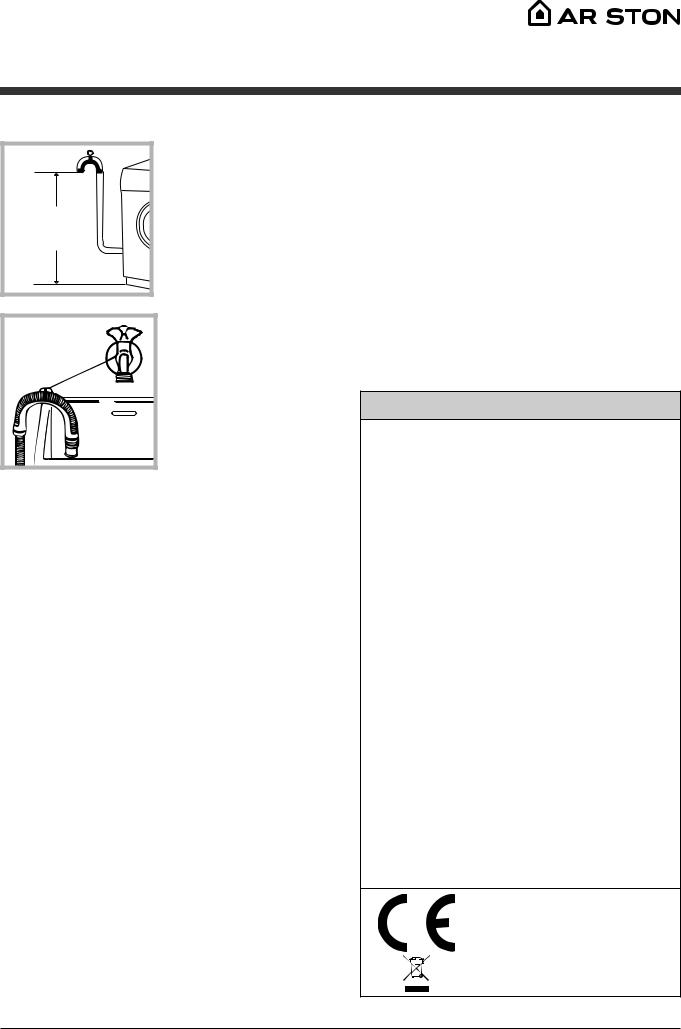
Connecting the drain hose
65 - 100 cm |
Connect the drain hose, without bending it, to a drain duct or
a wall drain situated between 65 and 100 cm from the floor;
alternatively, placed it over the edge
of a basin, sink or tub, fastening the duct supplied to the tap (see figure). The free end of the hose should not be underwater.
! We advise against the use of hose extensions; if it is absolutely necessary, the extension must have the same diameter as the original hose and must not exceed 150 cm in length.
Electrical connections
Before plugging the appliance into the electricity socket, make sure that:
•the socket is earthed and complies with all applicable laws;
•the socket is able to withstand the maximum power load of the appliance as indicated in the Technical data table (see opposite);
•the power supply voltage falls within the values indicated in the Technical data table
(see opposite);
• the socket is compatible with the plug of the washing machine. If this is not the case, replace the socket or the plug.
!The washing machine must not be installed outdoors, even in covered areas. It is extremely dangerous to leave the appliance exposed to rain, storms and other weather conditions.
!Once the machine has been installed, the electricity socket should be easily accessible.
!Avoid using any extension cord or multiple socket outlet.
!CAUTION: if this appliance is supplied from a cord extension set or electrical portable outlet device, the cord extension set or electrical portable outlet device must be positioned so that it is not subject to splashing or ingress of moisture.
|
|
|
! The cable should not be bent or compressed. |
|
|
GB |
||
! The cable should be replaced only by |
|
|
authorised technicians. |
|
|
! If the supply cord is damaged, it must be replaced |
|
|
by the manufacturer, its service agent or similarly |
|
|
qualified persons in order to avoid a hazard. |
|
|
Warning! The company shall not be held |
|
|
responsible in the event that these regulations |
|
|
are not respected. |
|
|
The first wash cycle
Once the appliance has been installed, and before you use it for the first time, run a wash cycle with detergent and no laundry, using wash cycle number auto clean (see “Cleaning the washer-dryer”).
Technical data
Model |
RDPG 96407 |
|
|
|
|
|
width 59.5 cm |
|
Dimensions |
height 85 cm |
|
|
depth 60.5 cm |
|
|
from 1 to 9 kg for the wash |
|
Capacity |
programme |
|
from 1 to 6 kg for the drying |
||
|
||
|
programme |
|
Electrical |
please refer to the technical |
|
connections |
data plate fixed to the machine |
|
|
maximum pressure |
|
Water con- |
1 MPa (10 bar) |
|
minimum pressure |
||
nections |
||
0.05 MPa (0.5 bar) |
||
|
||
|
drum capacity 71 litres |
|
Spin speed |
up to 1400 rotations per |
|
minute |
||
|
||
Energy ra- |
|
|
ted |
wash: programme 8; temp. |
|
programmes |
||
according to |
60°; 1400 rpm, using a load |
|
AS/NZS |
of 9 kg. |
|
2040.2 |
drying: programme 8 with |
|
and |
the “A3” dryness level. |
|
AS/NZS |
|
|
2442.2 |
|
This appliance conforms to the following EC Directives:
-2004/108/EC (Electromagnetic Compatibility)
-2006/95/EC (Low Voltage)
- 2012/19/EU (WEEE)
3

Care and maintenance
|
Cutting off the water and |
|
GB |
||
electricity supplies |
||
|
||
|
• Turn off the water tap after every wash cycle. |
|
|
This will limit wear on the hydraulic system |
|
|
inside the washer-dryer and help to prevent |
|
|
leaks. |
|
|
• Unplug the washer-dryer when cleaning it |
|
|
and during all maintenance work. |
|
|
Cleaning the washer-dryer |
•The outer parts and rubber components of the appliance can be cleaned using a soft cloth soaked in lukewarm soapy water. Do not use solvents or abrasives.
•The washer-dryer has a auto clean programme for its internal parts that must be
run with no load in the drum.
A |
To help the wash cycle |
you may want to use |
|
|
either the detergent |
|
(i.e. a quantity 10% the |
|
quantity specified for |
|
lightly-soiled garments) |
|
or special additives |
|
to clean the washer- |
|
dryer. We recommend |
|
running a cleaning |
programme every 40 wash cycles.
To start the programme press button A for 5 seconds (see figure).
The programme will start automatically and will run for about 70 minutes. To stop the cycle press the START/PAUSE button.
Cleaning the detergent dispenser drawer
1 |
2 |
Remove the dispenser by raising it and pulling it out (see figure).
Wash it under running water; this operation should be repeated frequently.
Caring for the door and drum of your appliance
•Always leave the porthole door ajar in order to prevent unpleasant odours from forming.
Cleaning the pump
The washer-dryer is fitted with a self-cleaning pump which does not require any maintenance. Sometimes, small items (such as coins or buttons) may fall into the pre-chamber which protects the pump, situated in its bottom part.
! Make sure the wash cycle has finished and unplug the appliance.
To access the pre-chamber:
1. using a screwdriver, remove the cover panel on the lower front part of the washer-dryer (see figure);
2. unscrew the lid by rotating it anti-
clockwise (see figure): a little water may trickle out. This is perfectly normal;
3.clean the inside thoroughly;
4.screw the lid back on;
5.reposition the panel, making sure the hooks are securely in place before you push it onto the appliance.
Checking the water inlet hose
Check the inlet hose at least once a year. If there are any cracks, it should be replaced immediately: during the wash cycles, water pressure is very strong and a cracked hose could easily split open.
! Never use second-hand hoses.
4
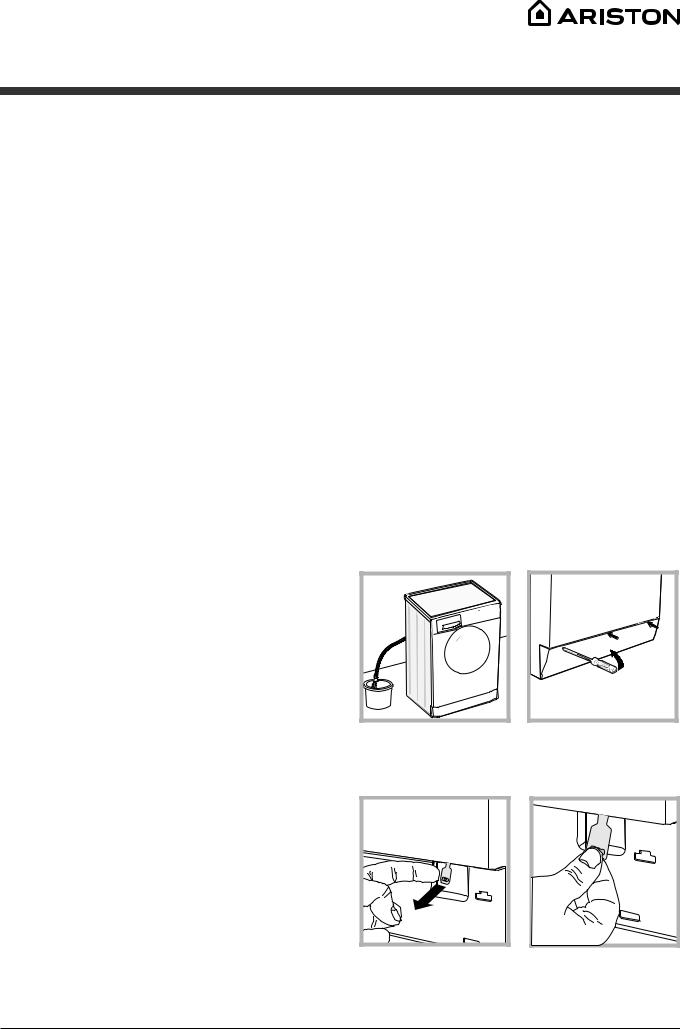
Precautions and tips
! This washer-dryer was designed and constructed in accordance with international safety regulations. The following information is provided for safety reasons and must therefore be read carefully.
General safety
• This appliance was designed for domestic use only.
• This appliance can be used by children aged from
8 years and above and persons with reduced physical, sensory or mental capabilities or lack of experience and knowledge if they have been given supervision or instruction concerning use of the appliance in a safe way and understand the hazards involved. Children shall not play with the appliance. Cleaning and user maintenance shall not be made by children without supervision.
– Do not dry unwashed items in the tumble dryer.
– Items that have been soiled with substances such as cooking oil, acetone, alcohol, petrol, kerosene, spot removers, turpentine, waxes and wax removers should be washed in hot water with an extra amount of detergent before being dried in the tumble dryer.
– Items such as foam rubber (latex foam), shower caps, waterproof textiles, rubber backed articles and clothes or pillows fitted with foam rubber pads should not be dried in the tumble dryer.
– Fabric softeners, or similar products, should be used as specified by the fabric softener instructions.
– The final part of a tumble dryer cycle occurs without heat (cool down cycle) to ensure that the items are left at a temperature that ensures that the items will not be damaged. WARNING: Never stop a tumble dryer before the end of the drying cycle unless all items are quickly removed and spread out so that the heat is dissipated.
•Oil-affected items can ignite spontaneously, especially when exposed to heat sources such as in a tumble dryer. The items become warm, causing an oxidation reaction in the oil. Oxidation creates heat. If the heat cannot escape, the items can become hot enough to catch fire. Piling, stacking or storing oil-affected items can prevent heat from escaping and so create a fire hazard. If it is unavoidable that fabrics that contain vegetable or cooking oil or have been contaminated by hair care products be placed in a tumble dryer they should first be washed in hot water with extra detergent - this will reduce, but not eliminate, the hazard.
•Do not touch the machine when barefoot or with wet or damp hands or feet.
•Do not pull on the power supply cable when unplugging the appliance from the electricity socket. Hold the plug and pull.
•Do not open the detergent dispenser drawer while the machine is in operation.
•Do not touch the drained water as it may reach extremely high temperatures.
•Never force the porthole door. This could damage the safety lock mechanism designed to prevent accidental opening.
•If the appliance breaks down, do not under any circumstances access the internal mechanisms in an attempt to repair it yourself.
•Always keep children well away from the appliance while it is operating.
•The door can become quite hot during the wash cycle.
•If the appliance has to be moved, work in a group of two or three people and handle it with the utmost care. Never try to do this alone, because the appliance is very heavy.
•Before loading laundry into the washer-dryer, make sure the drum is empty.
•During the drying phase, the door tends to get quite hot.
• Do not use the appliance to dry clothes that |
|
|
GB |
||
have been washed with flammable solvents |
||
(e.g. trichlorethylene). |
|
|
|
||
• Do not use the appliance to dry foam rubber |
|
|
or similar elastomers. |
|
|
• Make sure that the water tap is turned on during |
|
|
the drying cycles. |
|
|
• Children of less than 3 years should be kept |
|
|
away from the appliance unless continuou- |
|
|
sly supervised. |
|
|
• Remove all objects from pockets such as |
|
|
lighters and matches. |
|
|
Disposal |
|
•Disposing of the packaging materials: observe local regulations so that the packaging may be re-used.
•The European Directive 2012/19/EU on Waste
Electrical and Electronic Equipment, requires that old household electrical appliances must not be disposed of in the normal unsorted municipal waste stream. Old appliances must be collected separately in order to optimise the recovery and recycling of the materials they contain and reduce the impact on human health and the environment. The crossed out “wheeled bin” symbol on the product reminds you of your obligation, that when you dispose of the appliance it must be separately
collected. Consumers should contact their local authority or retailer for information concerning the correct disposal of their old appliance.
Opening the porthole door manually
In the event that it is not possible to open the porthole door due to a powercut, and if you wish to remove the laundry, proceed as follows:
1. remove the plug from the electrical socket.
2.make sure the water level inside the machine is lower than the door opening; if it is not, remove excess water using the drain hose, collecting it in a bucket as indicated in the figure.
3.using a screwdriver, remove the cover panel on the lower front part of the washer-dryer (see figure).
4.pull outwards using the tab as indicated in the figure, until the plastic tie-rod is freed from its stop position; pull downwards and open the door at the same time.
5.reposition the panel, making sure the hooks are securely in place before you push it onto the appliance.
5
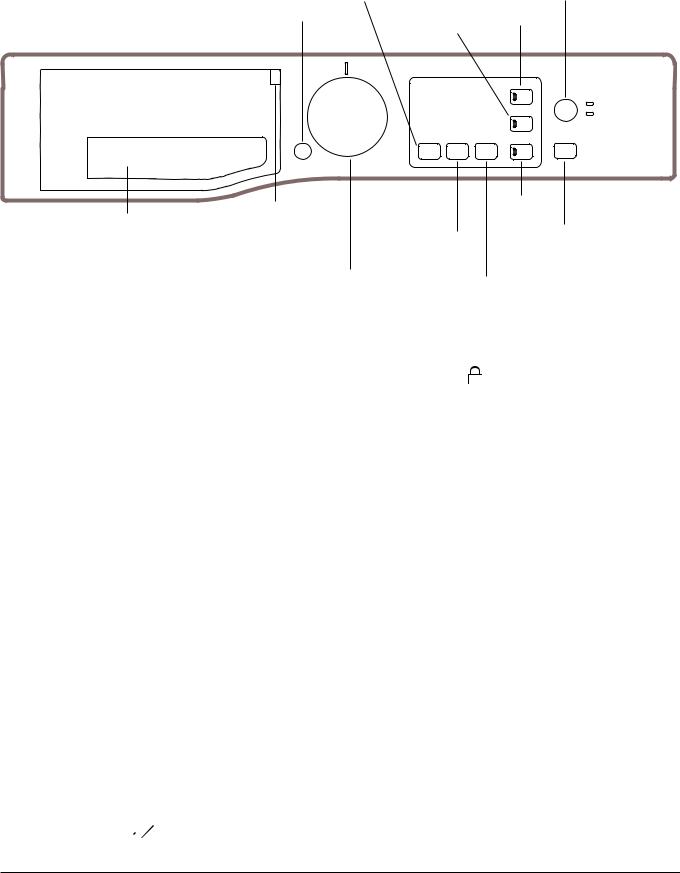
Description of the washer-dryer
|
|
|
|
|
|
|
|
|
Control panel |
|
CLEANING |
||
GB |
|
|
ACTION |
|||
|
|
TEMPERATURE |
button and |
|||
|
|
|
CHILD indicator |
|
light |
|
|
|
|
button |
|
||
|
|
|
|
|||
|
|
|
DRYING ONLY |
LOCK |
|
|
|
|
ON/OFF |
button |
button |
|
|
|
|
button |
|
|
|
|
|
|
|
|
|
|
|
DISPLAY
|
|
|
|
DELAY |
START/PAUSE |
|
|
Programme |
SPIN |
button and indicator |
|||
|
|
|||||
Detergent dispenser drawer |
Key |
|
TIMER light |
|||
WASH |
button |
|||||
|
button |
|
||||
|
|
|
|
|||
|
|
CYCLE |
|
|
|
|
|
|
SELECTOR |
|
DRYING |
|
|
|
|
KNOB |
|
|
||
|
|
|
button |
|
||
|
|
|
|
|
||
Detergent dispenser drawer: used to dispense detergents and washing additives (see “Detergents and laundry”).
Programme Key: the Programme Key inside the detergent dispenser shows all the available programmes together with a graphical guide on how to use the
individual dispenser compartments.
ON/OFF  button: press this briefly to switch the machine on or off. The START/PAUSE indicator light which flashes slowly in a green colour shows that the machine
button: press this briefly to switch the machine on or off. The START/PAUSE indicator light which flashes slowly in a green colour shows that the machine
is switched on. To switch off the washer-dryer during the wash cycle, press and hold the button for approximately 3 seconds; if the button is pressed briefly or accidentally the machine will not switch off.
If the machine is switched off during a wash cycle, this wash cycle will be cancelled.
WASH CYCLE SELECTOR KNOB: used to set the desired wash cycle (see “Table of programmes and wash cycles”).
CLEANING ACTION button and indicator light  : to select the desired wash intensity.
: to select the desired wash intensity.
TEMPERATURE  button: press to reduce or completely exclude the temperature; the value appears on the display.
button: press to reduce or completely exclude the temperature; the value appears on the display.
SPIN  button: press to reduce or completely exclude the spin cycle; the value appears on the display.
button: press to reduce or completely exclude the spin cycle; the value appears on the display.
DELAY TIMER  button: press to set a delayed start for the selected wash cycle; the delay period appears on the display.
button: press to set a delayed start for the selected wash cycle; the delay period appears on the display.
DRYING button  : press to decrease or exclude drying; the selected drying level or time will appear on the display.
: press to decrease or exclude drying; the selected drying level or time will appear on the display.
DRYING ONLY button 

 : press to run the drying cycle only.
: press to run the drying cycle only.
START/PAUSE button and indicator light: when the green indicator light flashes slowly, press the button to start a wash cycle. Once the cycle has begun the indicator light will remain lit in a fixed manner. To pause the wash cycle, press the button again; the indicator light will flash in an amber colour. If the symbol is not illuminated, the door may be opened. To start the wash cycle from the point at which it was interrupted, press the button again.
CHILD LOCK button: to activate the control panel lock, press and hold the button for approximately 2 seconds. When the symbol  is illuminated, the control panel
is illuminated, the control panel
is locked (apart from the ON/OFF button). This means it is possible to prevent wash cycles from being modified accidentally, especially where there are children in the
home. To deactivate the control panel lock, press and hold the button for approximately 2 seconds.
Standby mode
This washer-dryer, in compliance with new energy saving regulations, is fitted with an automatic standby system which is enabled after about 30 minutes if no activity is detected. Press the ON-OFF button briefly and wait for the machine to start up again.
Consumption in off-mode: 0,5 W Consumption in Left-on: 8 W
6
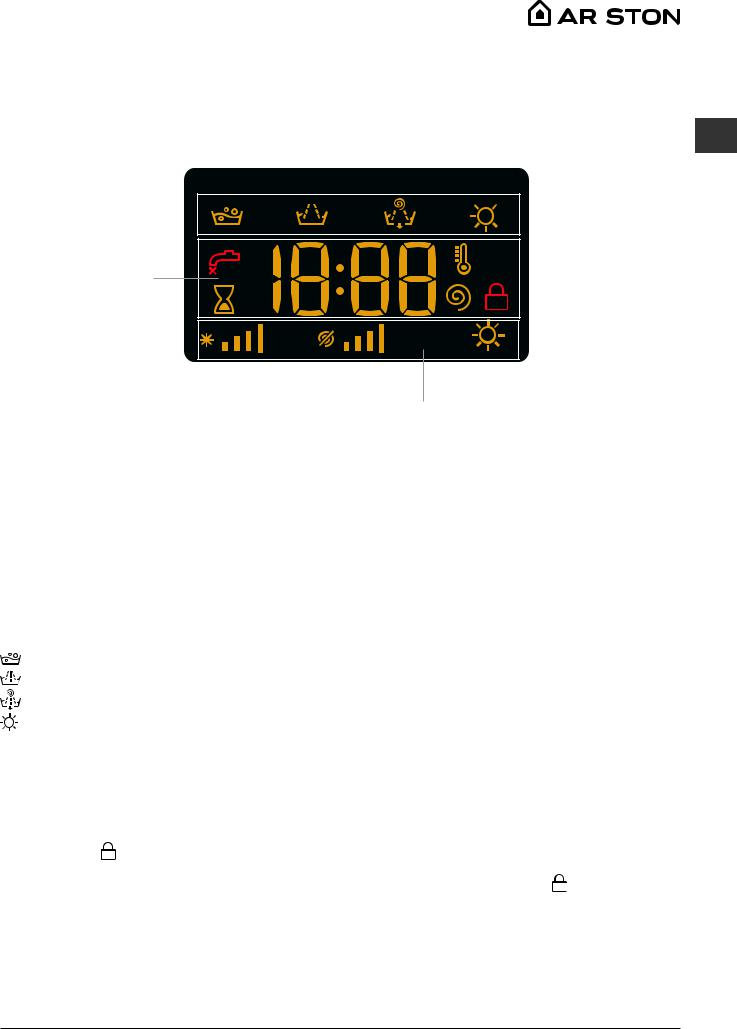
|
|
|
|
|
|
|
|
|
|
|
|
|
|
|
|
|
|
|
|
|
|
|
|
|
|
|
|
|
|
Display |
B |
||||||||
|
|
|
|
|
|
|
|
|
|
|
|
|
|
|
|
|
|
|
|
|
|
|
|
|
|
|
|
|
|
|
|
|
|
|
|
|
|
|
|
|
|
|
|
|
|
|
|
|
|
|
|
|
|
|
|
|
|
|
|
A
C
GB
The display is useful when programming the machine and provides a great deal of information.
The duration of the available wash cycles and the remaining time of a running cycle appear in section A (the display will show the maximum duration of the cycle chosen, which may decrease after several minutes, since the effective duration of the programme varies depending on the wash load and the settings chosen); if the DELAY TIMER option has been set, the countdown to the start of the selected wash cycle will appear.
Moreover, pressing the relative button allows for visualising the maximum values for the temperature, spin speed or type of drying relative to the selected programme or the most recently selected ones, if compatible with the selected programme.
The “wash cycle phases” corresponding to the selected wash cycle and the “wash cycle phase” of the running wash cycle appear in section B:
Main wash
Rinse
Spin/Pump out Drying
The icons corresponding to “temperature”, “spin” and “drying” (working from the left) are displayed in section C. The “temperature” bars 



 indicate the maximum temperature level which may be selected for the set cycle. The “spin” bars
indicate the maximum temperature level which may be selected for the set cycle. The “spin” bars 



 indicate the maximum spin level which may be selected for the set cycle.
indicate the maximum spin level which may be selected for the set cycle.
The  symbol lights up while the drying settings are being adjusted.
symbol lights up while the drying settings are being adjusted.
DOOR LOCKED indicator light:
The lit symbol indicates that the door is locked. To prevent any damage, wait until the symbol turns off before opening the door. To open the door while a cycle is in progress, press the START/PAUSE button; if the DOOR LOCKED symbol is switched off the door may be opened.
7
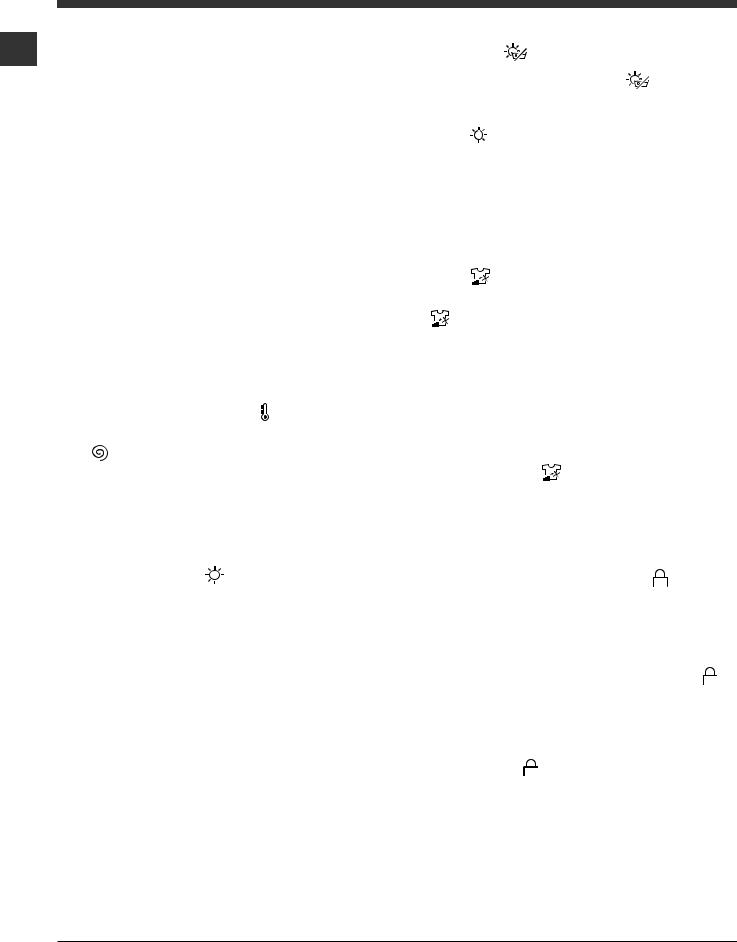
How to run a wash cycle or a drying cycle
1. SWITCH THE MACHINE ON. Press the  button;
button;
GB the START/PAUSE indicator light will flash slowly in a green colour.
2.LOAD THE LAUNDRY. Open the porthole door. Load the laundry, making sure you do not exceed the maximum load value indicated in the table of programmes and wash cycles on the following page.
3.MEASURE OUT THE DETERGENT. Pull out the detergent dispenser drawer and pour the detergent into the relevant compartments as described in “Detergents and laundry”.
4.CLOSE THE DOOR.
5.SELECT THE WASH CYCLE. Use the WASH CYCLE SELECTOR knob to select the desired wash cycle. A temperature and spin speed is set for each wash cycle; these values may be adjusted. The duration of the cycle will appear on the display.
6.CUSTOMISE THE WASH CYCLE. Use the relevant buttons:
Modify the temperature and/or spin speed.
The machine automatically displays the maximum temperature and spin speed values set for the selected cycle, or the most recently-used settings if they are compatible with the selected cycle. The temperature
can be decreased by pressing the button, until the cold wash “OFF” setting is reached. The spin speed may be progressively reduced by pressing the button, until it is completely excluded (the
“OFF” setting). If these buttons are pressed again, the maximum values are restored.
!Exception: if the 7 programme is selected, the temperature can be increased up to a value of 90°C.
!Exception: if the 9 programme is selected, the temperature can be increased up to a value of 60°C.
Setting the drying cycle |
|
The first time the button |
is pressed, the machine will |
automatically select the maximum drying cycle which is compatible with the selected wash cycle. Subsequent presses will decrease the drying level and then the drying time, until the cycle is excluded completely (“OFF”).
Drying may be set as follows:
A- Based on the desired laundry dryness level:
Iron “A1”: suitable for clothes which will need ironing afterwards. the remaining dampness softens creases, making them easier to remove.
Hanger “A2”: ideal for clothes which do not need to be dried fully.
Cupboard “A3”: suitable for laundry which can be put back in a cupboard without being ironed.
B - Based on a set time period: between 45 and 210 minutes.
If your laundry load to be washed and dried is much greater than the maximum stated load, perform the wash cycle, and when the cycle is complete, divide the garments into groups and put some of them back in the drum. At this point, follow the instructions provided for a “Drying only” cycle. Repeat this procedure for the remainder of the load. A cooling-down period is always added to the end of each drying cycle.
Drying only |
|
|
Press button |
to perform the drying-only cycle. |
|
After selecting the desired cycle (compatible with |
||
the type of garments), press button |
to exclude |
|
the washing phase and start the drying phase at the maximum level for the selected cycle. The drying level or time may be set and changed by pressing the drying
button |
. (Not compatible with cycles 1-2-3-4 and |
14). |
|
Setting a delayed start.
To set a delayed start for the selected cycle, press the corresponding button repeatedly until the required delay period has been reached. To remove the delayed start setting, press the button until the text “OFF” appears on the display.
Set the desired wash intensity.
Option makes it possible to optimise washing based on the level of soil in the fabrics and on desired wash cycle intensity. For heavily-soiled garments press
button until the “Intensive” level is reached. This level ensures a high-performance wash due to a larger quantity of water used in the initial phase of the cycle and due to increased drum rotation. It is useful when removing the most stubborn stains.
It can be used with or without bleach. If you desire bleaching, insert the extra tray compartment (3). When pouring in the bleach, be careful not to exceed the “max” level marked on the central pivot (see figure pag. 10).
For lightly-soiled garments or a more delicate treatment of the fabrics, press button until the “Délicate” level is reached. The cycle will reduce drum rotation
to ensure washing results that are perfect for delicate garments.
7.START THE WASH CYCLE. Press the START/ PAUSE button. The corresponding indicator light will turn green, remaining lit in a fixed manner, and the
door will be locked (the DOOR LOCKED symbol will be lit). To change a wash cycle while it is in progress, pause the washer-dryer using the START/PAUSE button (the START/PAUSE indicator light will flash slowly in an amber colour); then select the desired cycle and press the START/PAUSE button again.
To open the door while a cycle is in progress, press the START/PAUSE button; if the DOOR LOCKED symbol is switched off the door may be opened. Press the START/PAUSE button again to restart the wash cycle from the point at which it was interrupted.
8.THE END OF THE WASH CYCLE. This will be indicated by the text “END” on the display; when the
DOOR LOCKED symbol switches off the door may be opened. Open the door, unload the laundry and switch off the machine.
! If you wish to cancel a cycle which has already begun, press and hold the  button. The cycle will be stopped and the machine will switch off.
button. The cycle will be stopped and the machine will switch off.
8
